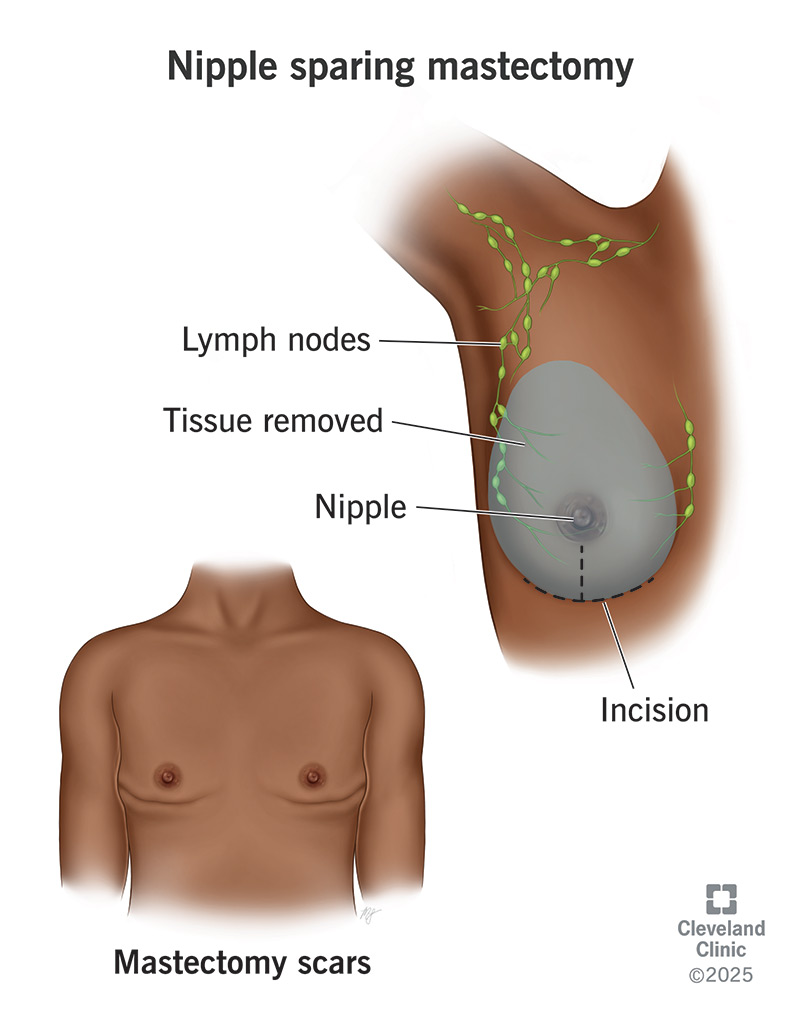A nipple-sparing mastectomy is an option for selected candidates planning their breast cancer surgery. In this procedure, your surgeon removes all your breast tissue but leaves the outer “envelope” — the skin and nipple — intact. Your surgeon can then reconstruct your breast form if you choose.
Advertisement
Cleveland Clinic is a non-profit academic medical center. Advertising on our site helps support our mission. We do not endorse non-Cleveland Clinic products or services. Policy

A nipple-sparing mastectomy (NSM) is a type of mastectomy — surgery to remove your breast tissue — that spares your nipple, areola and skin. This leaves a skin pocket to allow for reconstruction after the mastectomy.
Advertisement
Cleveland Clinic is a non-profit academic medical center. Advertising on our site helps support our mission. We do not endorse non-Cleveland Clinic products or services. Policy
You might be a candidate for nipple-sparing mastectomy if you plan to have reconstructive surgery at the same time as your mastectomy. You may also be a candidate if you:
Before scheduling your nipple-sparing mastectomy, your surgeon will take images of your breast with a mammogram, an ultrasound or an MRI. They’ll also:
Advertisement
In a nipple-sparing mastectomy, your surgeon will remove all the tissue that fills your breast while keeping the skin, nipple and areola intact. Typically, a cancer surgeon works closely with a plastic surgeon on this procedure.
Your surgeon will:
The timing of a nipple-sparing mastectomy can vary from person to person. It depends on the size and shape of your breast.
When it’s successful, a nipple-sparing mastectomy can be associated with a higher overall satisfaction rate compared to other types of mastectomies. But there’s a risk it won’t succeed if the nipple loses its blood supply during healing. The risk of breast cancer recurrence after NSM is the same as with other types of mastectomies.
The primary benefits include:
The primary risk is losing your nipple. The NSM operation can temporarily disrupt the blood flow to your skin and nipples. Blood flow should return with healing. But if your breast doesn’t heal well, and blood flow isn’t restored, the tissues can start to die.
A nipple-sparing mastectomy is usually an outpatient surgery. That means you go home the same day. Certain people may need to stay overnight at the hospital, but not always. Your clinical care team will make sure you’re healing well and provide pain relief as needed. They’ll teach you how to care for your incision wound and surgical drains at home. These drains will stay in place for about two weeks.
Advertisement
Bruising and swelling should go down in about a week. By this time, most people manage with over-the-counter pain relievers. You should avoid intense activity. But make sure to practice your arm exercises to prevent arm and shoulder stiffness. Most people return to their normal activities in a month or two.
Contact your provider if you notice any signs of complications during your recovery, like:
The nipple delay technique is a staged approach to performing a nipple-sparing mastectomy. Your surgeon first performs a breast reduction. Larger breasts tend to have less successful results with NSM. Reducing them in advance can improve the procedure’s chance of success.
But for some people with breast cancer, surgical delay isn’t the safest option. It might be more important to remove the cancer as soon as possible.
If you aren’t a candidate for nipple-sparing mastectomy, you might consider:
Advertisement
Planning for a mastectomy can be overwhelming — mentally and emotionally. Concerns about breast cancer, combined with concerns about losing your breast, can make decisions feel very difficult. In this setting, the thought of being able to keep your nipple, areola and breast skin may bring some comfort.
Not everyone is a candidate for nipple-sparing mastectomy. This could be due to the size and shape of your breast, or where the cancer is in your breast. Both you and your surgeon want the procedure to succeed, and not to have to repeat it. But for well-selected candidates, NSM can succeed both as a cancer treatment and as a cosmetic solution.
Advertisement
A breast cancer diagnosis can turn your world upside down. At Cleveland Clinic, we offer expertise, compassion and personalized treatment plans.

Last reviewed on 10/06/2025.
Learn more about the Health Library and our editorial process.